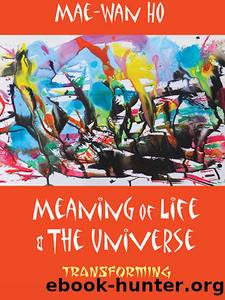Meaning of Life and the Universe:Transforming by Mae-Wan Ho

Author:Mae-Wan Ho
Language: eng
Format: azw3
Publisher: World Scientific Publishing Company
Published: 2017-01-23T16:00:00+00:00
8
Non-Random Directed Mutations and Quantum Electrodynamics
The neo-Darwinian theory of evolution by natural selection of random mutations should be consigned to history where it belongs; electromagnetic intercommunication and resonance may be involved in activating and mutating just the right genes.
An Obsolete Theory Challenged by Directed Mutations
Conventional neo-Darwinian theory of evolution is firmly based on the natural selection of random mutations plus the central dogma assumption that environmental influences cannot change nucleic acids or become inherited. The central dogma has been invalidated at least since the early 1980s concomitantly with the emergence of the new genetics of the fluid genome.1,2 Similarly, the randomness of mutations has been called into question since the 1970s in experiments demonstrating that cells subject to non-lethal selection come up repeatedly with just the right “adaptive” or “directed” mutations in specific genes that enable the cells to grow and multiply.3,4
Note that mutations adaptive for cells in enabling them to grow and multiply are not so for the organism as a whole, as they give rise to tumours and cancers; hence it is more appropriate to refer to them as “directed” mutations. In fact, it was the idea that cancers may involve directed mutations that prompted British physician and molecular geneticist John Cairns, then at Harvard School of Public Health in Boston, Massachusetts, to study the phenomenon in bacteria.5
In one of the first experiments demonstrating directed mutations, a strain of E. coli bacterium — with a mutation in the lacZ gene that terminates the polypeptide prematurely and hence renders it unable to use lactose — only mutated back to the wild-type when lactose is present in the medium, not when lactose was absent.3 Even more remarkably, another strain with the lacZ completely deleted was able to mutate a cryptic gene ebgA coding for an enzyme that could hydrolyze lactose and the regulator ebgR that normally represses ebgA. During growth, each of these point mutations occurs at a frequency of less than 10–8; neither on its own would allow the lacZ-deleted strain to use lactose.6
Cairns and colleagues concluded their 1988 review on the origin of mutants as follows:3
“Curiously, when we come to consider what mechanism might be the basis for the forms of mutation described in this paper, we find that molecular biology has, in the interim, deserted the reductionists. Now, almost anything seems possible. In certain systems, information freely flows back from RNA to DNA, genomic instability can be switched on under conditions of stress, and switched off when the stress is over, and instances exist where cells are able to generate extreme variability in localized regions of their genome. The only major category of informational transfer that has not been described is between proteins and the messenger RNA (mRNA) molecules that made them. If a cell discovered how to make that connection, it might be able to exercise some choice over which mutations to accept and which to reject.”
As it happens, reverse translation as suggested by Cairns is not needed, and the same mechanisms for directed mutations could apply from E.
Download
This site does not store any files on its server. We only index and link to content provided by other sites. Please contact the content providers to delete copyright contents if any and email us, we'll remove relevant links or contents immediately.
| Cell Biology | Developmental Biology |
| Entomology | Marine Biology |
| Microbiology | Molecular Biology |
| Biostatistics |
Sapiens: A Brief History of Humankind by Yuval Noah Harari(13053)
The Tidewater Tales by John Barth(12030)
Do No Harm Stories of Life, Death and Brain Surgery by Henry Marsh(6336)
Mastermind: How to Think Like Sherlock Holmes by Maria Konnikova(6236)
The Thirst by Nesbo Jo(5785)
Why We Sleep: Unlocking the Power of Sleep and Dreams by Matthew Walker(5642)
Sapiens by Yuval Noah Harari(4537)
Life 3.0: Being Human in the Age of Artificial Intelligence by Tegmark Max(4507)
The Longevity Diet by Valter Longo(4445)
The Rules Do Not Apply by Ariel Levy(3906)
The Immortal Life of Henrietta Lacks by Rebecca Skloot(3826)
The Body: A Guide for Occupants by Bill Bryson(3801)
Why We Sleep by Matthew Walker(3772)
Animal Frequency by Melissa Alvarez(3755)
Yoga Anatomy by Kaminoff Leslie(3701)
Barron's AP Biology by Goldberg M.S. Deborah T(3632)
The Hacking of the American Mind by Robert H. Lustig(3580)
All Creatures Great and Small by James Herriot(3516)
Yoga Anatomy by Leslie Kaminoff & Amy Matthews(3396)
